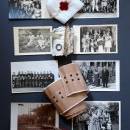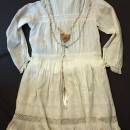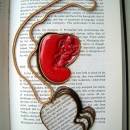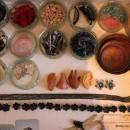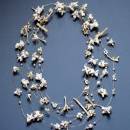Philosophy
Jivan Astfalck’s artistic research activities focus on wearable and decorative objects, which exist outside the margins of a recognised design culture, signified by a continuous dynamic of rediscovery, recycling of meaning and appropriation. These objects resonate with intimacy and passionate investment, rather than a functional design agenda. It is body adornment that exists in stark contrast to the overwhelming standardisation generated by mechanised commodity production, a ‘folk-art’ of our own culture.
The relationship between the finding, collecting and conceptualising of marginalized artefacts and their meaning is explored within the area of metaphorical symbolisation. Jivan is interested in jewellery pieces that map out the demarcation lines, where body meets world, a place, or idea of a place, where narratives are invested in objects with the aim to negotiate that gap, complexity, confusion or conflict in relation to private and subjective mental experience.
There is a correlation between literature and creative activity. The love of reading complicated literature and continental philosophy has over an elongated period of time enabled a pattern to evolve. By isolating ideas and voices verbalised in literature and pitching against other often conflicting ones is like a kaleidoscope. You throw them around and they make a pattern, a new pattern, often more eloquent. These groups of ideas over time became her thesis.
Quotations
1. Astfalck, Jivan, Narrative Structures in Body Related Crafts Objects, PhD Thesis, University of Arts, London, March 2007, pp 15.
Professor Jivan Astfalck PhD
Jivan Astfalck is a visual artist, jeweller and academic. Born in Berlin, where she was trained as a goldsmith, she has been living in London for more than 20 years. She obtained her MA in the History and Theory of Modern Art at Chelsea College of Art and Design and her PhD in Fine Art at the University of the Arts London. Dr Astfalck is now Professor at the Birmingham Institute of Art and Design, Birmingham City University and combines her studio practice, which she exhibits internationally, with teaching as the MA Course Director in Jewellery, Silversmithing and Related Product. Her main focus and research interest is in using hermeneutic philosophy, literary theory and other appropriate thought models as tools to investigate narrative structures embedded in body related crafts objects. In her view, the convergence of crafts, design and fine art practices is conductive to extending the theoretical vocabulary and map out new territories where crafts practices contribute to cultural production and dissemination.
Her publications and conference contributions include
TableManners, TR11/01, Royal Academy of Fine Arts, Antwerp, 2011; Traditional craft: manufactured nostalgia or grass-root resistance?, The Journal of Modern Crafts’ (online), Murray, K. (ed.), 2009; Lifelines, in ‘The International Journal of the Arts in Society’, volume 3, number 1, 2008; Difference and Resemblance in ‘Six Views on a Practice in Change’, Crafts In Dialogue-IASPIS, Stockholm, 2005; Whose Jewellery is it anyway? in ‘Challenging Crafts’, The Robert Gordon University, 2004
Commissions include
The Sting of Passion, Manchester Arts Galleries, 2009; Going Places, for Architecture Week and New Generation Art (NGA), Birmingham UK, 2007; I-con, for Forum für Schmuck und Design, Germany, 2005; Hide, for ‘Self,’ touring, Craftspace & Angel Row Gallery & Bury St Edmunds Art Gallery, UK, 2004; On Memory and Loss, for ‘Acknowledged Sources’ exhibition project, Hastings Museum and Art Gallery, UK, 2001

